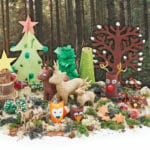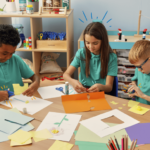
Author: Alice Sharp
Around the age of three children are beginning to develop their imagination and enjoy storytelling, which can make mythical creatures like fairies, dragons, or Jack Frost intriguing to them.
They may be particularly drawn to these creatures in books, cartoons, and stories, as their imaginations are becoming more vivid and creative. Mythical creatures offer a sense of wonder and magic that appeals to young children as they explore the boundaries of what’s real and imaginary.
Jack Frost is a mythical character often shown as a mischievous spirit, almost as if he was winter itself. He brings the cold, frost and snow and loves to play games with it.
In folklore Jack F is known for his talent to leave ice patterns on windows, to cause frost to form on surfaces and make the winter air feel even colder.
In European folk stories he is often described as playful, sometimes a little ‘naughty’ as he ‘nips’ peoples noses and cheeks on cold winter days.
Frosty Small World Landscapes
• Gather a range of materials of different textures and shades of white and blue.
• Place them all together in a space that allows your children to use them to create little worlds of their own imagining.
• Make sure you have a variety of interesting objects, that can be used to bring their imaginations to life and will allow them to create their own stories about the characters and adventures they have.
In more recent times Jack has been shown as more of a whimsical figure, shown as a young boy with icy blue or white hair.
In Jack Frost by Janet and Allan Ahlberg and in Rise of the Guardians he is seen as a hero figure.
Mythical creatures were used in ancient cultures to explain the mysteries of nature like Thor – the norse God of Thunder or the Dragon in many ancient Chinese stories. It was hoped that these creatures helped us make sense of the unknown.
These stories are often deeply rooted in a group’s values, beliefs and history, tying together the identity of a group.
Such as the Lion, who often stands for courage or the dragon who is full of wisdom.
Most of these mythical creatures were used to convey moral value or to teach ideas, unicorns and griffins were seen as virtues of human behaviour.
Humans have a natural inclination for storytelling and using their imagination. These mythical creatures are often a product of this creative thought passed down through generations.
Some mythical creatures symbolise human emotions, characteristics or struggles. They often help people comfort and deal with fear. They can explain, enrich and humanise the world around us.
Create your own mythical environments with these resources from Hope:
HP00053930 – Magical Metallic Acorn Cottages from Hope Education – Pack of 3
HP00056934 – Mythical Animal Set with Wool Detailing from Hope Education – Pack of 5
HP00053552 – Fantasy Play Tower from Hope Education
HP00051891 – Silicone and Wooden Mushrooms from Hope Education – Pack of 12
HP00057641 – Wooden Mushrooms from Hope Education – Pack of 10
HP00055169 – Felt Elves from Hope Education – Pack of 12
HP00052029 – tickit Wooden Enchanted Figures – Pack of 10
Back to Jack Frost. Why Frost? What actually is frost?
Frost is the little ice crystals that form when the air gets really cold, usually at nighttime. It looks like tiny sparkles or a white coating on the ground, trees or windows. It happens when water in the air freezes and turns to ice.
These little patterns could be seen like chilly decorations, like little crystals that come and then melt, fading and disappearing, as if by magic!
Frost Bites Hunt
• Create little pockets of water in places the children are likely to find them. This will only work if it’s really cold outside. Keep a watch on the weather and do this when you know there is likely to be frost in the morning.
• You could in fact create little pieces of ice shavings in piles for them to discover, encouraging them to go on a Frost Bite Hunt.
• Use sprinkling of icing sugar or flour over the grass and corners in the ground. You could sprinkle a little on leaves or bushes too.
Create a frosty path
• If you have some paper doilies or cut out snowflakes you could use them as shapes to sprinkle frosty patterns.
• Give each child a salt cellar or sugar sifter with salt, icing sugar, sugar or flour in.
• Allow each child to choose a frost or snowflake and to create their ‘path’ on the ground outside or on some dark coloured sugar paper.
They are like little pieces of nature that grow, with special shapes, like tiny treasures.
Jack Frost is a little sneaky, he comes out at night, paints the windows with sparkling light treasures. He makes the grass all shiny and white leaving frosty kisses everywhere all cold and bright.
These ice patterns he likes to leave could be tiny little gifts, to make us smile. Encourage your little ones to notice them as they appear on windows, at the edge of puddles or in the top of plant pots or ponds when it’s very cold.
Draw attention to the patterns, like delicate tiny branches, or swirly shapes almost like a small fairy drew them with a magic pencil or wand.
Frosty Treasures
• Gather a range of white and blue gems, crystals or even buttons.
• Suggest the children use them to create star, snowflake or spiky ice patterns.
• Suggest they take photos of them and then create a photo montage on the wall as a learning story. Capture the words the children use as they play.
Create little rhymes together
Little Jack Frost is quiet and small,
Tapping on windows, making snowflakes fall.
Jack frost paints trees with glitter and ice,
making the world sparkling and nice!
or
Frosty Jack nips your nose, your cheeks, your chin
Leaves frost on the ground, that makes you grin!
When you see snowflakes, twirling around,
You’ll know it’s Jack Frost, playing on the ground!
For many toddlers, these creatures and characters provide endless opportunities for pretend play, where they can act out stories or role-play with toys inspired by these mythical beings. The excitement of magical creatures will help support the development of the language, fantasy, and curiosity that children experience around 3 years old.



